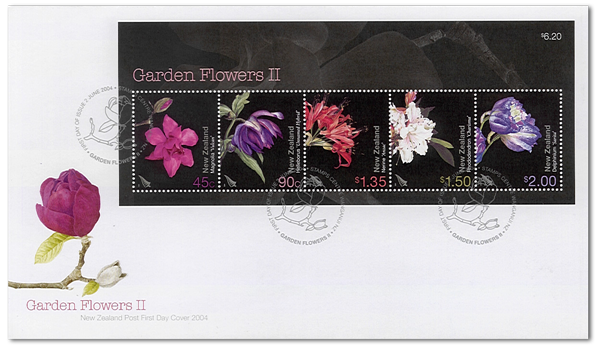What is it about gardening that makes it among the most popular physical activities in New Zealand? Is it the chance to enjoy the great outdoors while staying close to home? The satisfaction of seeing extraordinary beauty bloom from the plainest of seeds? Or merely the simple pleasure of hard work rewarded?
Whatever the reason, New Zealanders are garden-lovers on a grand scale, whether they are tending their own blooms or enjoying the fruits of others' labour in the many public botanical gardens and private estates open to view.
The Five Single Stamps.
45c - 'Magnolia Vulcan.'
Bred by the late Felix Jury, the 'Vulcan' attracted international acclaim for its dramatic deep-red-wine colouring and its cup-and-saucer shaped flowers. Felix was determined to create a magnolia that gardeners could grow at home; the result is a relatively small specimen that reaches four metres in 10 years.
90c - 'Helleborus Unnamed Hybrid.'
With an 1100-year history as a medicinal (although mildly poisonous) plant, the easy-care Helleborus (or winter rose) has been extensively cross-bred and today is a favourite winter-flowerer. Ken Telford's as-yet-unnamed double-purple hybrid is a fine example, a delightfully colourful sight in south Otago's often frosty winter conditions.
$1.35 - 'Nerine Anzac.'
The nerine is commonly known as the 'Guernsey lily', a name that arose in 1659 after a Dutch ship carrying bulbs from the Far East foundered and lost its cargo off the coast of the Channel island. Terry Hatch has added a new dimension to the story, naming his blood-red, April-blooming hybrid 'Anzac' in tribute to the soldiers of the Australia New Zealand Army Corps.
$1.50 - 'Rhododendron Charisma.'
Taranaki's Pukeiti Rhododendron Trust is the world's largest public rhododendron garden, with a 50-year history of breeding and growing these spectacular flowers. It has been caring for 'Charisma' since it arrived in New Zealand from Burma in 1951 - a true crowd-pleaser with its abundance of soft-pink, highly scented flowers that appear every October.
$2.00 - 'Delphinium Sarita.'
'Sarita' became part of New Zealand's floral landscape when breeder Terry Dowdeswell was cross-breeding for double-flowered hybrid delphiniums. This compact, strong and vigorously growing plant produces a flower spike about two metres long and with well over 100 individual, ruffle-edge florets - each a delicate shade of light blue with mauve tinting.
Other Collector Items.
First Day Cover - 2 June 2004.
First day cover with stamps affixed. Cancelled on the first day of issue.
Miniature Sheet with one 45c, one 90c, one $1.35, one $1.50 and one $2 stamp.
The Garden Flowers miniature sheet was a floral display in more ways than one - as well as presenting all five stamps in their pictorial splendour, the 45c magnolia was fragrantly perfumed! This was New Zealand Post's first-ever 'scratch and smell' stamp - a collector's item and pleasant sensory experience in one beautiful package.
Miniature Sheet First Day Cover - 2 June 2004.
First day cover with miniature sheet affixed. Cancelled on the first day of issue.
Presentation pack containing a selection of stamp products from the issue and further information on the Kiwi passion for gardening, the flowers and their breeders.
Technical information.
Date of issue: 2 June 2004.
The number of stamps: Five.
Denominations and designs: 45c Magnolia 'Vulcan', 90c Helleborus 'Unnamed Hybrid', $1.35 Nerine 'Anzac', $1.50 Rhododendron 'Charisma', $2.00 Delphinium 'Sarita.'
Stamps and first-day cover illustrated: Susan Worthington.
Stamps designed: CommArts Design, Wellington.
Printer and process: Southern Colour Print, Dunedin by offset lithography.
The number of colours: Four process colours.
Stamp size and format: 30mm x 35mm (vertical).
Paper Type: Tullis Russell 104gsm red phosphor stamp paper.
The number of stamps per sheet: 50.
Perforation gauge: 13.85 x 13.75.
Period of sale: These stamps remained on sale until close of business 1 June 2005.
Some of the images in this post were used with permission from the illustrated catalogue of StampsNZ
You can visit their website and Online Catalogue at, http://stampsnz.com/
Information & images for this post came from.










We appreciate your engagement with our content. To ensure a respectful and constructive community, please take note of the following:
- No Spam, Please: We do not tolerate spammy or promotional comments. Any such comments will be promptly removed.
- Moderation in Place: All comments are moderated to maintain a positive and inclusive environment. Please be patient, as it may take a little time for your comment to appear.
- Sign In with Google: To comment, please sign in using your Google account. This helps us maintain the integrity of our community and allows for better interaction.